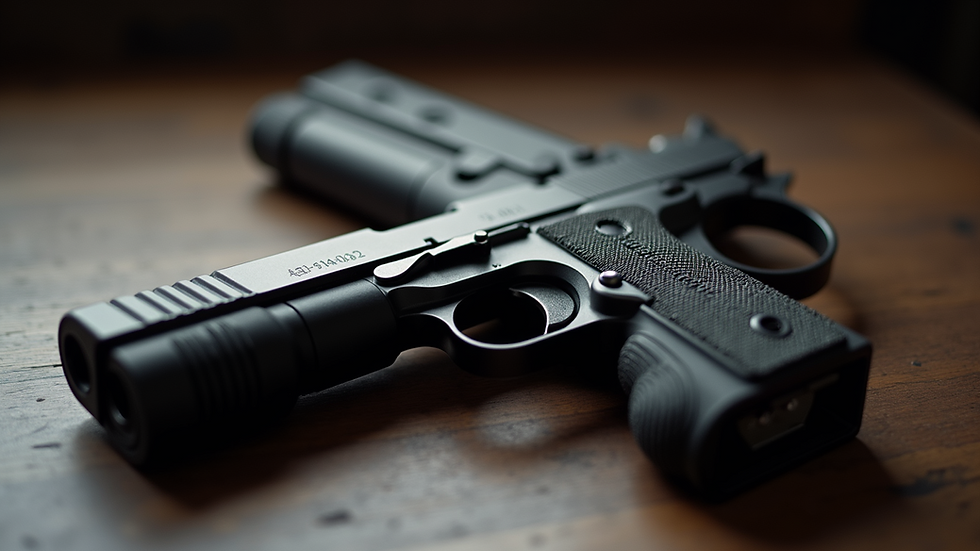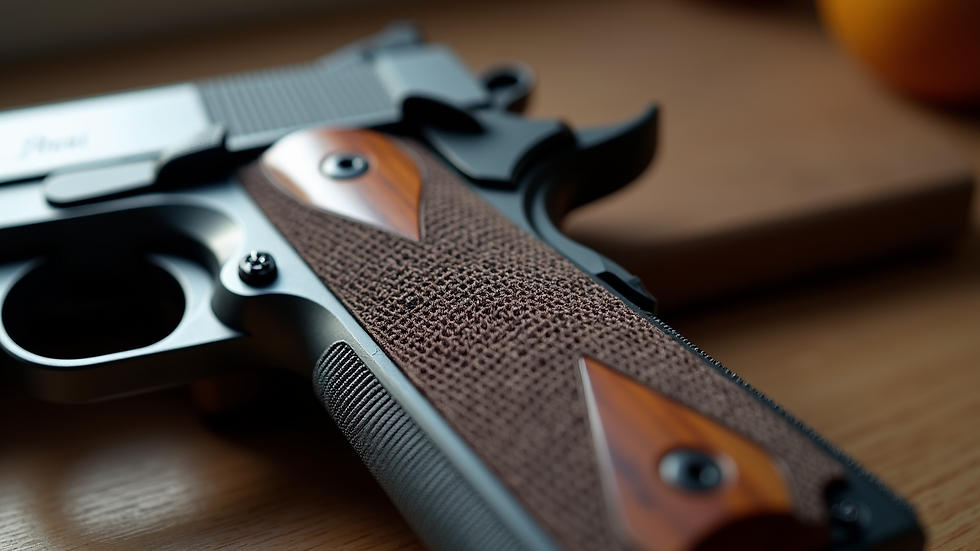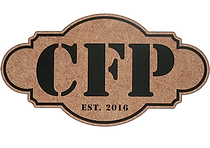1911 Frame Dimensions Explained
- Custom Firearm Products

- Sep 22
- 4 min read
When it comes to classic handguns, the 1911 is a timeless icon. Whether you’re a seasoned shooter or just starting to explore firearms, knowing the standard 1911 dimensions is essential. These measurements affect everything from grip comfort to holster fit and overall handling. Today, I’m breaking down the key dimensions of the 1911 frame, explaining why they matter, and sharing tips to help you get the most out of your firearm.

What Are the Standard 1911 Dimensions?
The 1911 pistol was originally designed by John Browning over a century ago, and its dimensions have become a benchmark for many handguns. The standard 1911 dimensions refer to the typical measurements of the frame, slide, barrel, and grip that define this model.
Here are some of the most important measurements you should know:
Overall length: Approximately 8.5 inches
Barrel length: Usually 5 inches for the full-size model
Height: Around 5.25 inches
Width: Roughly 1.25 inches
Weight: About 2.44 pounds (unloaded)
These dimensions make the 1911 a balanced handgun that fits comfortably in most hands. The grip size is particularly important because it affects how you hold and control the pistol during shooting.
If you want to dive deeper into the specifics, you can check out detailed charts and resources on 1911 frame dimensions.
Why These Dimensions Matter
The size and shape of the 1911 frame influence several factors:
Ergonomics: A well-sized frame fits your hand better, improving accuracy and comfort.
Holster compatibility: Knowing the exact dimensions helps you pick or customize holsters.
Customization: Many shooters like to modify their 1911s, and understanding the frame size is crucial for fitting aftermarket parts.

How to Measure Your 1911 Frame Accurately
If you own a 1911 or are thinking about buying one, measuring the frame yourself can be very helpful. Here’s a simple step-by-step guide:
Get a caliper: A digital caliper is the best tool for precise measurements.
Measure the length: From the back of the slide to the muzzle.
Measure the height: From the bottom of the grip to the top of the slide.
Measure the width: Across the widest part of the frame.
Check the grip circumference: Wrap a tape measure around the grip to see how it fits your hand.
Taking these measurements will give you a clear idea of your pistol’s size and help you compare it to other models or aftermarket parts.
Tips for Customizing Your 1911 Frame
Grip panels: Swapping out grip panels can change the feel without altering the frame.
Beavertail grip safety: Adding or adjusting this can improve comfort and control.
Trigger reach: Some frames allow you to adjust the trigger position for better finger placement.

Why Do 1911s Jam So Much?
One common question I hear is why 1911 pistols sometimes jam or fail to cycle properly. While the 1911 is a reliable design, several factors can cause jams:
Ammunition issues: Using low-quality or underpowered ammo can cause feeding problems.
Dirty or poorly maintained gun: Residue buildup can interfere with the slide and barrel movement.
Improper grip: The 1911 is sensitive to how you hold it; a limp wrist can cause cycling failures.
Worn or mismatched parts: Springs, extractors, or magazines that don’t fit well can cause malfunctions.
The good news is that most jams are preventable. Regular cleaning, using quality ammo, and practicing a firm grip will keep your 1911 running smoothly. If you’re customizing your pistol, make sure all parts are compatible with the standard frame dimensions to avoid fitment issues.
Choosing the Right 1911 Frame Size for You
Not all 1911s are created equal. While the full-size model is the most common, there are also Commander and Officer sizes with shorter barrels and frames. Here’s a quick comparison:
| Model | Barrel Length | Overall Length | Weight (unloaded) |
|-------------|---------------|----------------|-------------------|
| Full-Size | 5 inches | 8.5 inches | 2.44 pounds |
| Commander | 4.25 inches | 7.75 inches | 2.1 pounds |
| Officer | 3.5 inches | 6.75 inches | 1.8 pounds |
Choosing the right size depends on your needs:
Full-size: Best for home defense, competition, and range shooting.
Commander: A good balance for concealed carry and comfort.
Officer: Ideal for deep concealment but may sacrifice some accuracy.
Knowing the standard 1911 dimensions helps you decide which model fits your lifestyle and shooting style.
Final Thoughts on 1911 Frame Dimensions
Understanding the dimensions of your 1911 frame is more than just trivia. It’s about making your shooting experience better, safer, and more enjoyable. Whether you’re customizing your pistol, buying accessories, or just curious, knowing these measurements gives you confidence.
If you want to explore more about the technical side, including detailed specs and customization options, check out this resource on 1911 frame dimensions. It’s a great place to start your journey into the world of 1911 pistols.
Remember, the 1911 is a classic for a reason. With the right knowledge and care, it can be a reliable companion for years to come. Happy shooting!



Comments